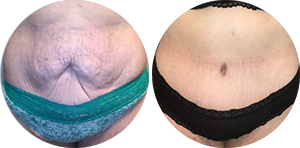Gynecomastia is a condition that causes men to develop excessive breast tissue. This condition is quite common—approximately a third of male children develop gynecomastia during puberty, which typically subsides when they reach adulthood and their hormones stabilize. However, for approximately 10% of men, this condition persists into adulthood. (1) Surgical correction is the most effective treatment for enlarged breasts that will not respond to other methods. Addressing gynecomastia can improve patients’ self-esteem and confidence.
At Allen Aesthetic Surgery, we have helped many patients improve their quality of life with customizable treatments. Dr. Amber L. Allen, a boarded general surgeon and a certified cosmetic surgeon recognized by the American Board of Cosmetic Surgery, brings an artistic approach to her work that makes her a sought-after specialist in her field. She is well-known for her transformative treatments that can rejuvenate the skin and body. She can help you achieve beautiful, natural-looking results and a more sculpted, masculine-looking chest with gynecomastia treatments.
Contact our office or call (919) 676-5052 to learn more about how we can help you improve your appearance.
Contents
- 1 About Gynecomastia
- 2 Benefits
- 3 Candidates & Consultation
- 4 Preparation
- 5 Procedure
- 6 After Your Procedure
- 7 Results
- 8 Additional Body Enhancement Treatments
- 9 Cost of Gynecomastia in North Carolina
- 10 FAQ
- 10.1 What is the recovery time after gynecomastia?
- 10.2 Will I have noticeable scars after my gynecomastia treatment?
- 10.3 How long will I need to wear the chest garment after receiving gynecomastia treatments?
- 10.4 Can I address gynecomastia with medications instead of surgery?
- 10.5 Is gynecomastia treatment permanent?
- 11 References
About Gynecomastia
Approximately 32-65% of men experience enlarged male breasts from gynecomastia in their lifetime, a condition that can cause anxiety and self-consciousness. (2) Gynecomastia is linked to hormonal changes, genetic conditions, medications, and weight fluctuations. As testosterone levels decline with age and estrogen increases, hormonal imbalances can result in enlarged male breasts. (3) This condition can impact your self-esteem and quality of life, socially and psychologically. (4) With this in mind, gynecomastia is a treatable condition—Dr. Allen can help you restore a more masculine chest!
Benefits
Gynecomastia does not have to be permanent, and the treatments associated with gynecomastia have several benefits, which may include:
- Improved self-esteem: You can enjoy feeling more confident about your appearance after addressing gynecomastia.
- Balanced body proportions: Sculpting the chest can help you balance your body proportions.
- Long-lasting results: You can enjoy long-lasting results if you take good care of your body and maintain a stable weight.
Candidates & Consultation
Suitable candidates for gynecomastia treatments are those who typically lead a healthy lifestyle and have realistic expectations about what they can achieve with gynecomastia treatment. Ideally, patients should be non-smokers or willing to quit using nicotine for this treatment. For the most part, eligible candidates for gynecomastia treatments are men suffering from enlarged breast tissue who are looking for an effective and long-lasting solution. (5) During your consultation, we will discuss your lifestyle, medications, and medical history to create an effective treatment plan. Ultimately, this consultation will establish your eligibility for gynecomastia treatments at Allen Aesthetic Surgery.
To schedule this personal consultation and see if you are an ideal candidate for gynecomastia treatments, contact Allen Aesthetic Surgery online or by calling (919) 676-5052.
Preparation
To prepare for a gynecomastia treatment, you should stop taking medications and supplements that thin the blood for 1-2 weeks before your procedure, with the approval of your primary care physician. If you smoke or vape, you should quit approximately 6 weeks before and after for the best results. Dr. Allen will provide specific instructions to help you prepare further.
Procedure
On the day of your appointment, you should arrive with clean skin and comfortable clothing. Dr. Allen will cleanse your skin and mark it for the procedure. You will also receive anesthesia. The procedure for addressing gynecomastia often includes one of the following procedures, or both:
- Liposuction: If the cause of the enlarged breasts is primarily fatty tissue, Dr. Allen can remove it with liposuction. She will make a small, discreet incision and administer tumescent fluid, causing the fat cells to swell for easier removal. With a thin cannula, she will remove the excess fat with gentle suction that preserves the surrounding tissue.
- Excisional Surgery: Dr. Allen will excise glandular tissue to remove excess tissue and create a more masculine-looking chest contour.
This procedure typically takes 2-3 hours.
After Your Procedure
After your procedure, you will need to rest for 7-10 days to allow yourself time to recover. You will need someone to drive you home and—ideally—assist you around your house after the procedure. Dr. Allen will provide a compression garment for you to wear as well as a set of detailed postoperative instructions. If you experience any discomfort, Dr. Allen advises that you wear a cold compress and can prescribe medication if necessary.
You should avoid strenuous exercise and heavy lifting for several weeks after your procedure. Dr. Allen will monitor your healing progress and address any concerns during your follow-up. Some patients who require extensive nipple areolar repositioning may receive drains to aid the body’s healing process. Swelling, bruising, and discomfort during the healing process are temporary and will gradually subside.
Results
Gynecomastia reduction surgery removes the excess breast tissue to contour the chest for a more masculine appearance. After reshaping the breasts, you can enjoy a smoother chest and improved self-confidence. You can maintain your results if you remain at a consistent weight; weight fluctuations can affect your results.
Additional Body Enhancement Treatments
Tummy Tuck
A tummy tuck is a procedure that removes excess, droopy skin from the midsection. For patients seeking additional body contouring following gynecomastia treatment, a tummy tuck can further enhance the overall aesthetic outcome. Abdominal skin laxity is often a concern for individuals who have undergone significant weight loss or who have loose skin due to aging factors.
Arm Lift
An arm lift (brachioplasty) is a procedure that removes excess skin from the arms, also known as “bat wings.” Droopy skin can swing uncomfortably, affecting the way your clothing fits. With a thin incision, we can tighten the skin, and we can also perform liposuction to emphasize your muscle definition. During an arm lift, Dr. Allen will make an incision along the underside of the arms to tighten the skin and remove excess tissue.
Fat Transfer
A fat transfer is a treatment that removes excess fat from one area of the body and reinjects it into another area to provide natural-looking volume to the skin. For men looking to enhance their overall body contours after gynecomastia surgery, fat transfer offers a natural, strategic way to improve definition and symmetry. This procedure involves removing unwanted fat from areas such as the abdomen, flanks, or thighs and carefully reinjecting it into areas that may benefit from additional volume or correction. Dr. Allen can administer the excess fat to multiple areas of the body, including the arms, hips, calves, and face.
Cost of Gynecomastia in North Carolina
The cost of gynecomastia surgery can vary based on the complexity of your case, the techniques used (such as liposuction, surgical excision, or both), and whether additional procedures are performed. During your consultation, Dr. Allen will develop a personalized treatment plan and provide a detailed cost estimate tailored to your goals.
Contact our office or call (919) 676-5052 to learn more about how we can help you improve your appearance.
FAQ
What is the recovery time after gynecomastia?
Recovery time varies depending on the type of procedure you receive. Patients should return to strenuous exercise no sooner than 4-6 weeks after their treatments—receiving approval from Dr. Allen before doing so is crucial.
Will I have noticeable scars after my gynecomastia treatment?
Dr. Allen takes care to make discreet incisions along the natural curves of your skin for natural-looking results. Liposuction alone leaves very discreet, barely noticeable scars.
How long will I need to wear the chest garment after receiving gynecomastia treatments?
Most patients are advised to wear their recovery garments for a few weeks after their procedure. We will monitor your progress during your follow-up appointments to provide specific instructions.
Can I address gynecomastia with medications instead of surgery?
This depends on the root cause of your gynecomastia. Some patients are able to address their gynecomastia with lifestyle changes or hormone treatments. However, for patients whose gynecomastia is a result of genetic factors, it can be very difficult to address without surgery.
Is gynecomastia treatment permanent?
Surgical gynecomastia treatment is long-lasting and effective, but it is possible that the condition recurs over time in some cases. We recommend maintaining a stable weight and making healthy lifestyle choices to lower the chances of recurrence.
References
- Tukenmez M, Emiroglu S, Kozanoglu E, et al. Single axillary incision endoscopic surgery and liposuction for gynecomastia. Medicine. 2023;102(7):e33020. doi:https://doi.org/10.1097/MD.0000000000033020
- Polat S, Cuhaci N, Evranos B, Ersoy R, Cakir B. Gynecomastia: Clinical evaluation and management. Indian Journal of Endocrinology and Metabolism. 2014;18(2):150. doi:https://doi.org/10.4103/2230-8210.129104
- Johnson RE, Murad MH. Gynecomastia: Pathophysiology, Evaluation, and Management. Mayo Clinic Proceedings. 2009;84(11):1010-1015. https://www.ncbi.nlm.nih.gov/pmc/articles/PMC2770912/
- Holzmer SW, Lewis PG, Landau MJ, Hill ME. Surgical Management of Gynecomastia. Plastic and Reconstructive Surgery – Global Open. 2020;8(10):e3161. doi:https://doi.org/10.1097/gox.0000000000003161
- Chang D, Siy R, Friedman J, Brown R. Trends in the Surgical Correction of Gynecomastia. Seminars in Plastic Surgery. 2015;29(02):122-130. doi:https://doi.org/10.1055/s-0035-1549053



